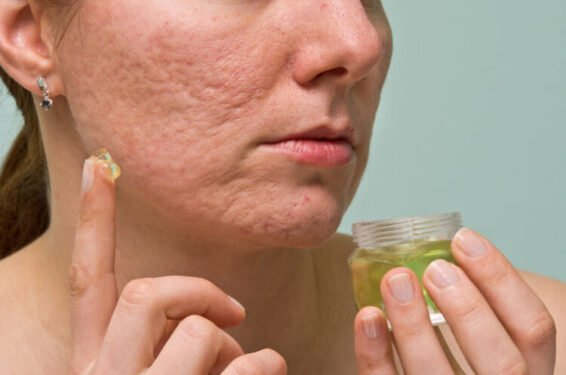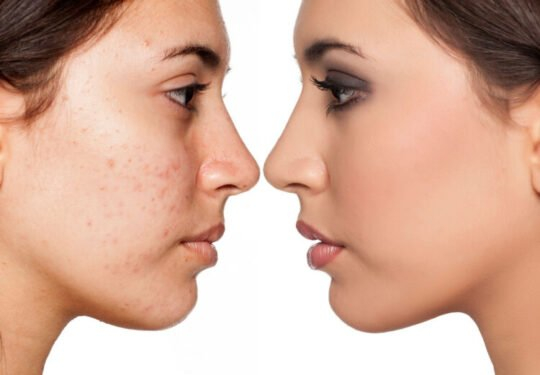The skin condition acne can cause scars known as boxcar scars. These scars create a round or oval depression or crater in the skin. Furthermore, most patients, have sharp vertical edges. Usually, the scars appear on the face, back and chest. These scars are often more severe in acne that has been treated too late or has not been treated.
Various treatments are possible for this scar. When the scars are not so deep, the prognosis is usually good, but deeper scars are more difficult to remove. Finally, prompt acne treatment lowers the chance of developing boxcar scars.
Formation of boxcar scars
Causes
Severe acne, a skin condition involving inflammation of the sebaceous glands, may damage the skin. The body wants to repair this skin damage and then forms collagen for this. Acne scars, usually a form of atrophic scarring, develop when the body does not produce enough collagen during this process. The skin then does not have enough support, which eventually causes scarring during the skin’s recovery process.
Risk factors
Untreated nodular cystic acne ( painful hard and large bumps under the skin), acne con
global (lumps and pustules on the face, trunk, and back), acne excoriée and hidradenitis suppurative (acne ectopia) are more likely to cause boxcar scars. The scars also occur more quickly by scratching the pimples or pricking them open. Furthermore, genetic factors play a role in the development of scars from the skin condition. Finally, severe and prolonged inflammatory processes also increase the risk of scarring.
Treatment of scar formation
The doctor looks at the redness, depth, and location of the acne scars and the patient’s skin type. Based on this information, he proposes a treatment. Patients with superficial scars are usually easier to treat than patients with deep scars. Often a combination of treatments is used to improve the appearance of the scars.
Chemical peels
Various chemicals destroy the top layer of the skin when a doctor uses chemical peels. The chemicals accelerate cell division in the skin. This causes the skin to peel off and fall off, allowing new, undamaged skin growth to emerge. Possible side effects include redness, pain, a skin infection, peeling of the skin, and darker skin color or, on the contrary, lighter skin color than usual. Darker-skinned patients are more likely to be affected by these skin changes.
Dermabrasion
Dermabrasion is a treatment method in which a device removes the entire top layer of skin. This method is especially useful for the face or on individual scars. Dermabrasion improves the appearance of superficial boxcar scars but is less effective for deeper scars. Side effects include redness and pain for several days and sensitivity to sunlight for several months.
Fillers (fillers)
The doctor injects fillers under the skin. These fillers end up under the scar, increasing the slump. This treatment sometimes causes redness of the skin, nodules, pain, and swelling. The fillers are temporary (the effects last for several months), or semi-permanent (the effects last for up to two years).
laser therapy
Laser therapy can also be used to reduce acne scars. The doctor has a choice of ablative and non-ablative lasers. Ablative lasers are the best choice for treating boxcar scars. Usually, one session is enough to achieve positive results. Ablative lasers damage the top layers of the skin and sometimes cause redness, pain, swelling, itching, and blisters. They also stimulate new collagen production and remodel the scar. Non-ablative lasers have the same mode of action, but they cause fewer side effects than ablative lasers. However, they are usually less effective. All laser treatments make the skin sensitive to the sun.
Microdermabrasion
Microdermabrasion is a superficial procedure in which the doctor removes the top layer of skin. The doctor rubs small crystals over the skin. This treatment method is not suitable for deep scars but has very few side effects. The results are variable.
Microneedling
With microneedling, the doctor uses a device with very thin needles that pierce the skin. This causes small injuries, which the body tries to repair. As a result, the body builds more collagen, which reduces the scars. Microneedling causes mild facial pain, facial swelling, and redness after the procedure.
Punchexcisie
In the punch excision treatment, a device splits the skin and then sews the skin edges together again. This forms a new scar, which heals, creating new undamaged skin. Punch excision is most effective for small scars that easily fit the shape of the punch tool. It only treats individual scars, not redness or bumps resulting from the scars. The doctor also uses this treatment method for the treatment of ice-pick scars, which is also a form of atrophic scarring.
Subcase
During subcision, the doctor places a needle under the skin and moves it in multiple directions to separate the top layer of skin from the underlying scar tissue. The resulting healing process produces collagen and pushes the scar upwards. This treatment method is usually less effective. However, the side effects are mild and short-lived, such as bruising and pain during the procedure.
Prognosis of acne scars
Acne scars sometimes fade, but they don’t go away completely on their own. Thanks to treatment, the appearance of the scars improves in the majority of patients, so that they are no longer always visible.























